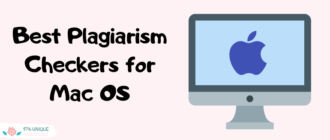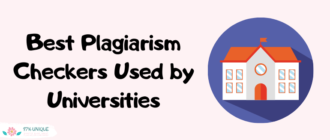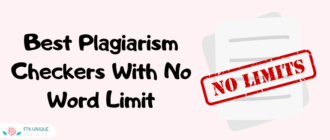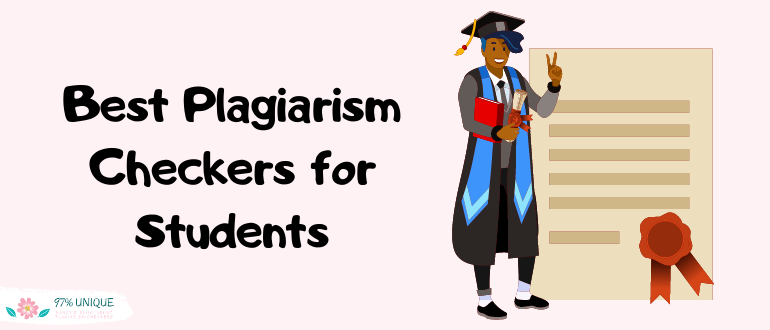
Plagiarism is using another person’s work in your paper without crediting the original source. The worst form is a word-for-word copy and paste. That is obvious stealing. Less obvious is not intentionally stealing but when a student writes something too similar to another source, which can happen accidentally.
Another form of plagiarism is self-plagiarism, which is using your work more than once as if you wrote a uniquely new piece. Students need to know that if you turn in one of your old papers, pretending it is new, that is self-plagiarism.
To avoid these problems, wise students check their assignments before submitting them with one of the best plagiarism checkers for students.
After reading this article, you will be able to compare plagiarism checkers so that you can:
- Choose the best plagiarism checker for students.
- Compare the free and paid plagiarism checkers.
- Avoid plagiarism in your assignments, which may cause you to get a poor grade or rejection of your paper.
While researching this article, I’ve checked 45 plagiarism checkers for students and then chose 12 for in-depth reviews.
For the fastest comparison, here are the strongest three features of each plagiarism checker for students, with the detailed reviews of each one to follow in the next section.
| Acceptable formats | Features | Price |
|---|---|---|
| Best Paid Checkers For Students | ||
| 1. Grammarly ↓ | ||
| Word docs, Open Office format, RTF, and .txt |
|
Free version without plagiarism checker. Paid individual version $144/year. Business team of three+ people $150 per member/year. |
| 2. Ouriginal ↓ | ||
| .doc, .docx, .html, .htm, .hwp, .odt, .odp, .ods, .pages (4), .pdf, .pdf 2.0, .ppt, .pptx, .ps, .rtf, .sxw, .tif, .tiff, .txt, .wps, .xls, .xlsx, and .zip |
|
Quoted for each institution. |
| 3. Unicheck ↓ | ||
| Text formats, .pdf, .xls, .xlsx, and .zip files |
|
The pay-as-you-go system starts at $5 for 20 pages, with discounts for volume use. |
| 4. Turnitin ↓ | ||
| All text formats |
|
Location fee for each campus of $1,500 plus $3 per year per student. |
| Best Free Checkers For Students | ||
| 1. Copyscape ↓ | ||
| Web pages |
|
Free version and paid version starting from three cents per word. Monthly subscription levels at $4.95/month and $19.95/month. |
| 2. Plagiarism Checker X ↓ | ||
| MS Word, Open Office, .pdf, RTF, and .txt |
|
Offers a free version and paid version for a one-time fee of $39.95. |
| 3. Quetext ↓ | ||
| All text formats |
|
Offers a free version and paid version at $9.99/month. |
| 4. Search Engine Reports ↓ | ||
| Word documents, .pdf files, RTF and .txt |
|
Free. |
| 5. PaperRater ↓ | ||
| Any text format |
|
Free version and paid version for $11.21 per month ($71.55/year) |
| 6. Grades Fixer ↓ | ||
| .doc .docx, .pdf, or .txt |
|
Free. |
| 7. Eduzaurus ↓ | ||
| .doc, .docx, .odt, .pdf, .rtf. and .txt |
|
Free. |
| 8. PlagiarismChecker.co ↓ | ||
| .doc, .docx, .txt, .pdf., and cloud document files |
|
Free version and paid version levels from $15 to $50 per month. |
Plagiarism can be a big problem if you are not diligent. Students need to check their work for plagiarism using modern tools.
In my experience, I found that some of the free plagiarism checkers work well for simple student papers. However, you probably want to use the most sophisticated paid versions to check serious academic papers if you are a student writing this format.
Plagiarism sometimes makes big news. Filmmaker Samantha Grant created a documentary film called A Fragile Trust released in 2013 that covered the scandal caused by Jayson Blair’s plagiarism while writing for the New York Times over many years.
The background of why Samantha Grant and Brittney Shepherd created a game and solution for students… #integrity2015 pic.twitter.com/b7xyMDP6Z2
— Turnitin (@Turnitin) April 23, 2015
Blair was a notorious plagiarist and fraudster. He copied quotations from other newspapers, made up interviews that never happened, and used fake sources. When challenged about his questionable work, he lied extensively to cover up what he did.
When Blair’s fraud became evident, he had to resign. He also took down his bosses, the Executive Editor, Howell Raines, and the New York Times Managing Editor, Gerald Boyd, who resigned.
Blair suffered from bipolar depression and was drug/alcohol-addicted at the time. However, even he admits in a Reporters Lab interview that those personal problems were no excuse for what he did.
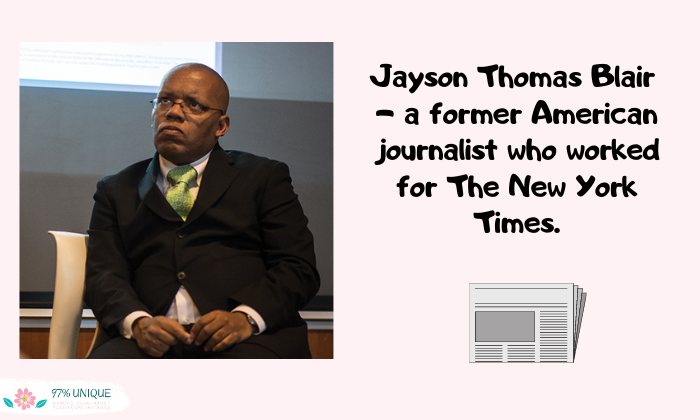
Do yourself a favor and eliminate plagiarism from your writing to avoid the calamities that it can cause.
To make it easier for students on a tight budget, I broke the reviews down into two main categories: the paid plagiarism checkers, followed by the free plagiarism checkers for students. Some free ones may also offer a paid version that allows a higher word count to be scanned and adds more features. Here are the detailed reviews of the best plagiarism checkers for students:
Best Paid Plagiarism Checkers for Students
Paid checkers students may access through an educational system. These checkers require paid versions to access the plagiarism checker.
1. Grammarly
Grammarly is a comprehensive toolkit that offers checking for plagiarism, grammar, punctuation, spelling, tone, passive verbs, and other excellent features to help improve a student’s writing.
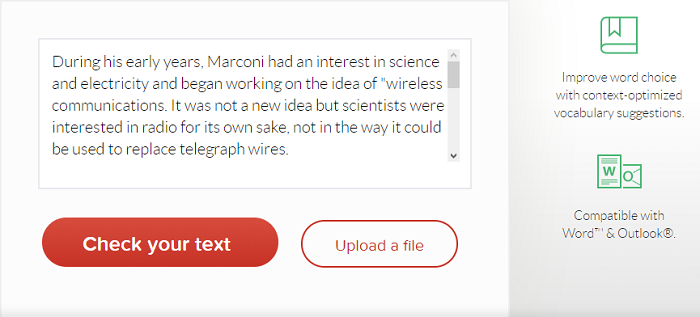
Text Length: The Grammarly is an online editor that allows analysis of up to 100,000 characters. A downloadable version works as an add-in for MS Word for Mac that analyses up to 150,000 characters. The downloadable version that is an add-in for MS Word for Windows does not have any character limit.
Acceptable Formats: Word docs, Open Office format, RTF, and .txt formats. Does not work with .pdf files.
Database Size: The analysis uses the ProQuest database for matching with more than 16 billion published online resources.
Pros
- Grammarly has over 30 million users, many of them are students.
- This comprehensive toolkit checks plagiarism, grammar, punctuation, and spelling.
- Available as an online tool, Windows desktop version, browser extensions, and MS Word add-in for Windows and Mac.
- Use of this tool significantly improves writing.
- AI-driven machine learning is used to constantly improve the analysis results
Cons
- Does not work with the .pdf file format.
- The free version does not check for plagiarism
- Does not check for AP style errors.
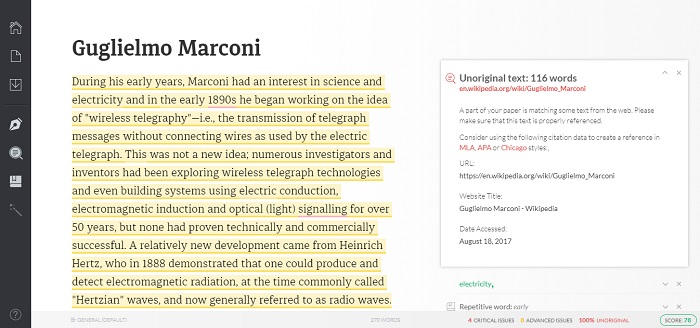
Price: There is a free version (without a plagiarism checker). Non-profit organizations can apply for a free business version. The individual user’s paid level is $144 annually. The team business version is $150 annually per user for three or more members. There are discounts given for ten users or more.
In this video, produced by Kindlepreneur, the reviewer takes a serious look at Grammarly and compares the free version with the paid version.
The reviewer is a bit like me. He uses Grammarly daily to improve his writing and protect himself from having any problems with plagiarism. He even credits Grammarly with one time saving his company.
Check out the detailed review of Grammarly →
2. Ouriginal
Ouriginal is a new system. The company was founded in 2020 in Sweden. This checker is designed for use by schools, colleges, and universities. That’s why students usually don’t have any problems with using this software. It has extensive integrations using its API that supports most learning management systems. The web service works with a REST protocol using JSON or XML over HTTP.

Text Length: Unlimited.
Acceptable Formats: The Ouriginal system accepts these formats: .doc, .docx, .html, .htm, .hwp, .odt, .odp, .ods, .pages (4), .pdf, .pdf 2.0, .ppt, .pptx, .ps, .rtf, .sxw, .tif, .tiff, .txt, .wps, .xls, .xlsx, and .zip (as email attachments for certain integrations).
Database Size: The Ouriginal includes billions of published web pages, books, reference works, scientific articles, previously submitted papers from students, and other content that is not accessible without password permission from the source.
Pros
- The analysis includes significant unpublished content in the database, such as student assignments that are not published on the web.
- Documents for analysis can be sent by students as an email attachment.
- Gives a matching/similarity score for potential plagiarism.
- Analysis reports can be downloaded by authorized users.
- Teachers have the option to share analysis reports with students or not.
Cons
- Submittal of the same document using different email accounts may result in a false positive for self-plagiarism.
- Students cannot access this system unless the institution has paid for a license.
- There is no way to delete any document from the system. Users must agree to allow documents to be permanently added to the database for future scanning.
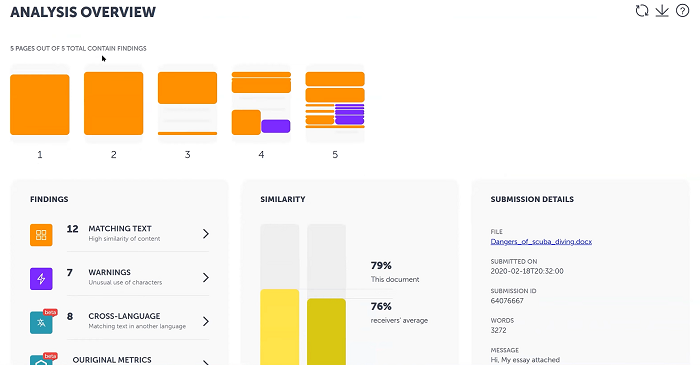
Price: The company quotes the paid service license for each educational institution based on the number of enrolled students.
If you want to know what teachers are using to detect plagiarism, read my article here.
This video, produced Ouriginal, gives a nice overview of the system and how it works.
The mission statement of the company is virtuous. Even though the company is new, it is a merger of groups with 30 years of previous work, that’s also a reason why I included this checker in my list of the best plagiarism checkers for students.
3. Unicheck
Unicheck is the system used by around 1,100 higher-educational organizations worldwide. The system integrates with all the popular LMS used by these institutions. The analysis is accessible through a SaaS cloud-based online toolkit, as an application, or through data connections made by using the API.

Text Length: The entry-level is limited to scans of up to 275 words per page and up to 20 pages. The paid premium version has no limits. Of course, I always recommend my student to use the paid version because it makes the checking process a lot easier.
Acceptable Formats: This software accepts most text formats, Google Drive documents, Adobe .pdf files, spreadsheets, and compressed files like zip files.
Database Size: Unicheck has one of the largest databases of online content with more than 91 billion web pages that are indexed by Google and Bing. Educational institutions have the option to add propriety databases to use for plagiarism checking.
Pros
- Offered as SaaS on the cloud servers for fast analysis.
- Easy to access online with all major browsers.
- SSL encryption protects document submissions while in transit on the web.
- Creates citations for APA, Chicago, Harvard, MLA, and Turabian styles.
- Document formatting is preserved during scanning.
Cons
- Prepayment required for use.
- Credit expires in six months if unused.
- Does not work offline.
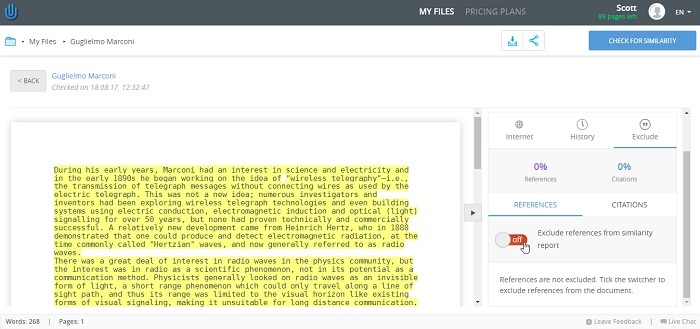
Price: Unicheck offers a free trial. Prepayment for the pay-as-you-go system is $5 for 20 pages. Prepayment of more pages gets a discount of up to 76% from the basic pricing. Enterprises with high volume can negotiate greater discounts.
This video, produced by Unicheck, shows how a teacher might use the Unicheck online analysis report.
Your teacher has to give you access to your report.
Check out the detailed review of Unicheck →
4. Turnitin
Turnitin is a comprehensive toolkit designed for universities. It has plagiarism checking along with many writing-improvement tools. The Turnitin system integrates well with popular learning management systems that include Brightspace, Blackboard, Moodle, Canvas, Schoology, and Moodle.
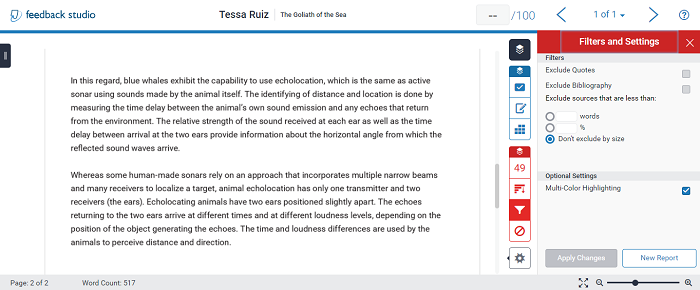
Text Length: Unlimited.
Acceptable Formats: Accepts all text formats.
Database Size: Turnitin uses a plagiarism-scanning database with more than seven trillion published resources. That’s a benefit for students who like to use published content in their works.
Pros
- Recognizes 12 common plagiarism types.
- Multilanguage support for 19 languages.
- Uses AI-driven machine learning to improve analysis results.
- Daily processing of more than one million analysis reports.
- Used by 81 of the 100 best global universities.
Cons
- Not available except through university systems.
- Pricey for an institution to get a general license if student enrollment is high.
- No stand-alone app.
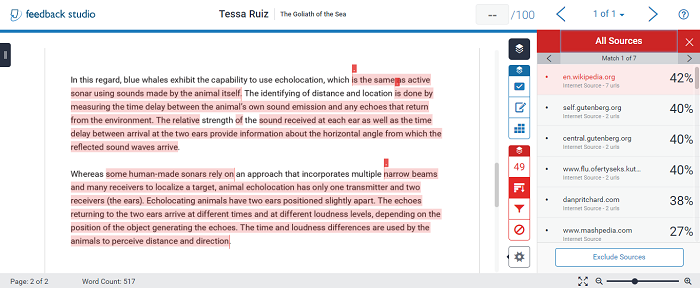
Price: Universities pay a location fee for each campus of $1,500 plus $3 per year per student based on active enrollment.
In this video, Hafsa Slaiman discusses the percentage number from your Turnitin report.
The interesting parts that she covers are the words-in-sequence checking and the checking that found some of her work.
Check out the detailed review of Turnitin →
Best Free Plagiarism Checkers for Students
Some of these free checkers also have paid premium versions.
1. Copyscape
Copyscape offers both a free version and a paid version. The free version uses the URL of the content to make the analysis. Students can check for plagiarism in their work for free while creating an assignment, as long as they have a way to publish the content on the web. One way is by using a temporary HTML file on a website. Using the paid version, Teachers can check for plagiarism in assignments after students turn them in. If you are a teacher, you may also be interested in reading my review of the best plagiarism checkers for teachers here.
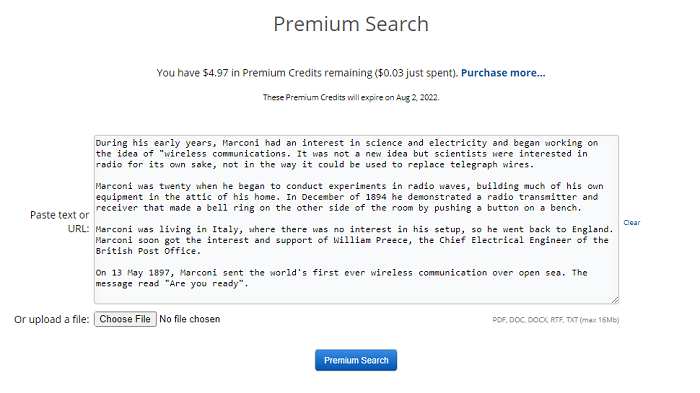
Text Length: Analysis can check up to 10,000 published web pages at a time, for duplicate content on the web.
Acceptable Formats: The free version only uses web pages.
Database Size: Copyscape uses the search indexes created by Google and Bing of billions of web pages.
Pros
- Easy to use for plagiarism checking of published web content.
- This tool uncovers copy and paste stolen content as well as partial plagiarism.
- Document comparison shows content matches and sources.
- The API integrates with most LMS used by educational institutions.
- Highlights show the similarities in the scanned material with the original material.
Cons
- Does not work for unpublished papers that cannot be found on the Internet.
- No archives are kept of the analysis reports.
- Cannot be used offline.
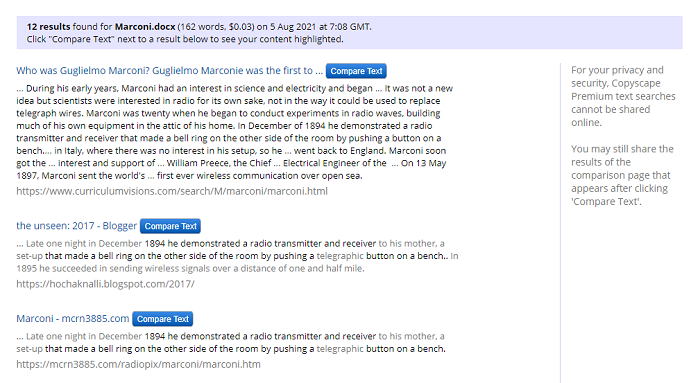
Price: Copyscape has a free version that can be accessed online. The paid versions start at the prepayment cost of three cents per word. There are monthly subscription levels at $4.95/month and $19.95/month.
In this video, the narrator talks about how he uses Copyscape to check plagiarism on his blog.
Copyscape works better for online published content than student papers. One workaround is to post your essay online temporarily using a free website hosted on a free service. You can put the paper online for the time that Copyscape needs to check it and then take it down afterward.
Check out the detailed review of Copyscape →
2. Plagiarism Checker X
Plagiarism Checker X is a tool that can be downloaded and used for free for up to 30 daily searches of 120 words.
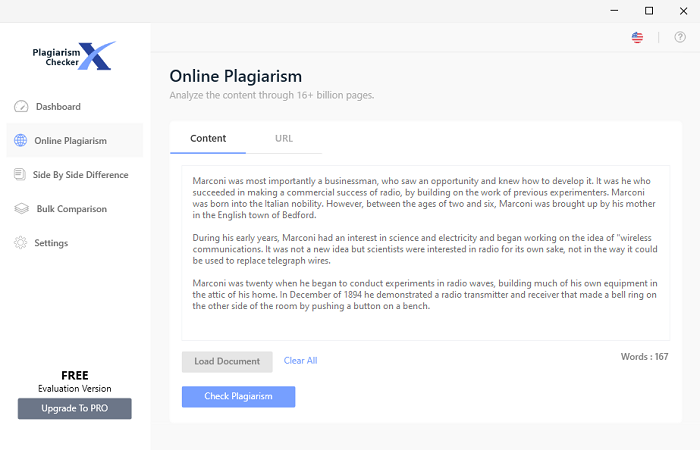
Text Length: Plagiarism Checker X has a tiny, annoying, limit of 120 words for a free search. To search a larger document requires breaking it up into small pieces. That’s actually inconvenient for students but it’s free.
Acceptable Formats: MS Word, Open Office, .pdf, RTF, and .txt files.
Database Size: The database used for analysis is over 16 billion online published resources.
Pros
- Side-by-side document comparison.
- Fast analysis.
- Bulk comparison tool.
- Searches for three consecutive words to find a match.
- The matching criteria can be adjusted.
Cons
- The 120 word limit for the free version is annoying for being so small.
- No Mac version available. Windows only.
- Plagiarism checking does not include spell checking or grammar.
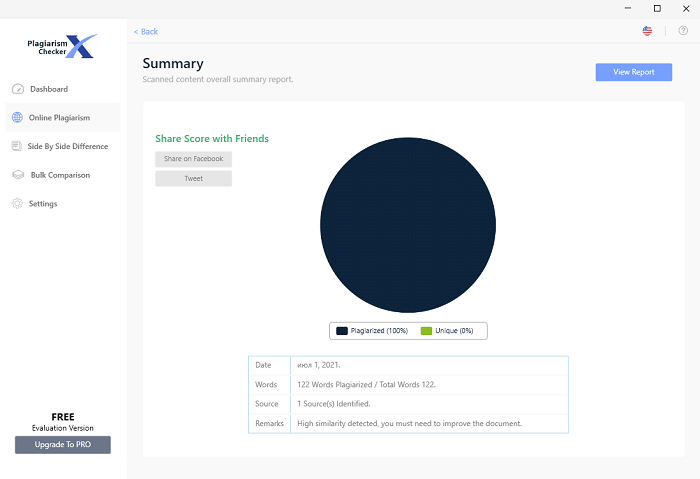
Price: Plagiarism Checker X has a free version that allows up to 30 daily searches of 120 words. The paid version is a one-time payment of $39.95. Non-profit organizations get a 20% discount from the paid prices. There are discounts for five users or more and additional discounts for 20 users or more. Students can make a group and get these discounts.
This video, produced by Madujith Sagara, shows a direct comparison between Turnitin and Plagiarism Checker X.
The winner of this head-to-head comparison is Turnitin. However, Turnitin is costly unless you get complimentary use of a license through an institution that pays for it. Plagiarism Checker X is more affordable, even if it is less accurate. For some uses, it will suffice.
3. Quetext
Quetext offers a free and paid version. Access to the tool is by using the home page of the company after signing up for the free version.
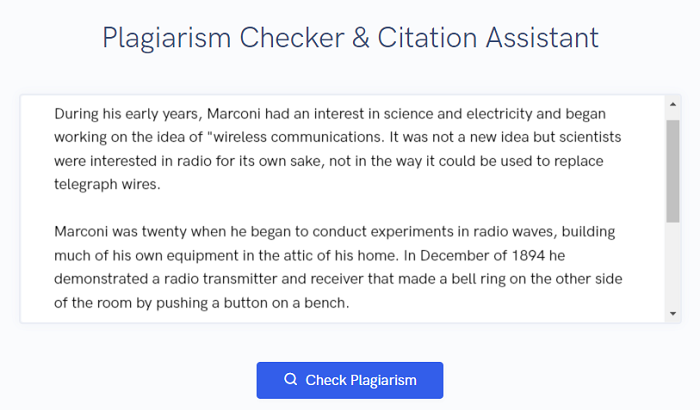
Text Length: The free version has a 2,500-word monthly limit. The paid monthly subscription version has a limit of 25,000 words per search and 100,000 words per month, without needing to purchase more credit.
Acceptable Formats: All text can be copied and pasted into a text box or uploaded in any popular format of a text document. Students often use different formats for different types of works so this checker lets them avoid converting problems, and that’s why it is one of the best plagiarism checkers for students.
Database Size: The Quetext analysis searches over 35 billion published web pages, one million academic journals, and more than 20 million published books.
Pros
- The database is one of the largest and includes academic journals and books.
- Uses AI-driven DeepSearch™ technology.
- Creates citations automatically.
- “Fuzzy” matching picks up more plagiarism matches.
- Excluding URLs is an option.
Cons
- Uploading files is only available with the paid version.
- Access to downloadable reports is restricted to the paid version.
- Month-by-month plan requires buying more credit to search more than 100,00 words (about 200 pages).
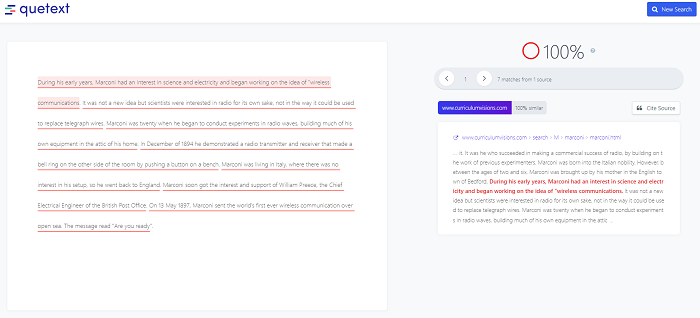
Price: Quetext’s free version has a 2,500-word monthly limit. The premium paid version is $9.99/month to scan up to 100,000 words.
Don’t be intimidated by the process of writing research papers. This video, produced by Surviving and Thriving in Higher Education, discusses how to write an essay over a weekend.
Professor Pete Carr from the University of Minnesota’s Chemistry Department describes the process he calls the “Algorithm” of writing a paper over a weekend, used by him and his team to write over 400 research papers.
The video focuses on producing the first draft quickly and making the process an enjoyable and rewarding experience.
4. Search Engine Reports
Search Engine Reports has an online free-to-use plagiarism tool. You can either cut and paste text into a text field or upload a document from your device or DropBox.
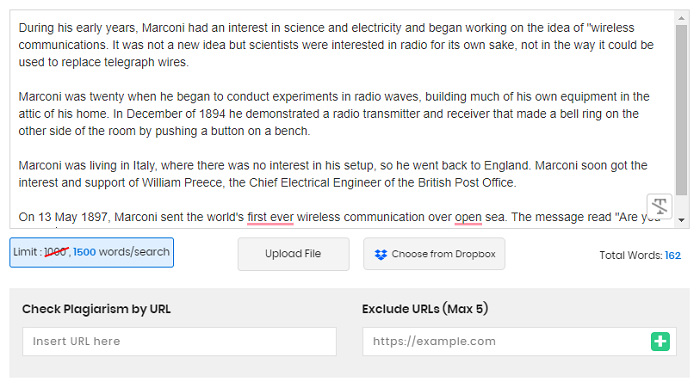
Text Length: There is a generous word count of 1,500 words for each analysis.
Acceptable Formats: Accepts word documents, .pdf files, RTF and .txt formats.
Database Size: The database used for the scan comprises many billions of web pages of content published online.
Pros
- The online tool can be used without any signup or registration.
- Support is available in 21 languages, that can be useful for students from different countries.
- Besides checking text files, you can also scan a URL.
- You have the option to exclude up to five URLs from the scan.
- There is an automatic deletion of any documents after they are scanned for a report.
- The analysis reports show content matches as highlights.
Cons
- Does not scan for matches in any books that are not published online. That’s a huge con for students who use old literature in their works.
- Some academic journals are missing from the database.
- Documents larger than about three pages of 500 words each, need to be broken into pieces.

Price: The plagiarism checker from Search Engine Reports is completely free.
5. PaperRater
PaperRater is a free online tool that is easy to use. It is powered by Ginger software. Simply cut and paste the content you want scanned for plagiarism in the text field. There is also a paid premium version.
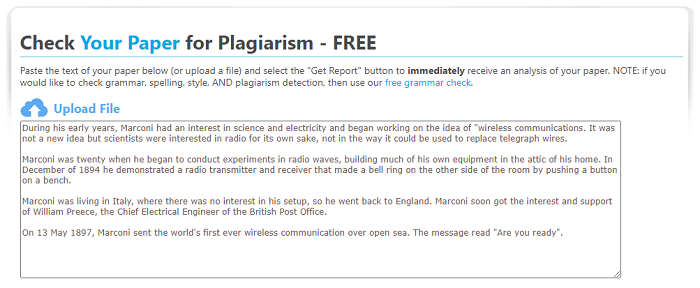
Text Length: The free service allows five pages of up to a total of 1,500 words. The paid premium service scans up to 20 pages in one scan.
Acceptable Formats: Any text format.
Database Size: The database for similarity checks contains billions of web pages indexed by Google and Bing.
Pros
- Easy-to-use, free, online tool.
- Also offers free grammar checking and vocabulary builder.
- Used by students in more than 100 countries.
- Uses advanced natural language processing.
- Results from analysis in five to 15 seconds.
Cons
- Cannot be used offline.
- The free version does not show highlighted matches in the original documents.
- The report can be printed with the free version but not downloaded directly and is not archived.
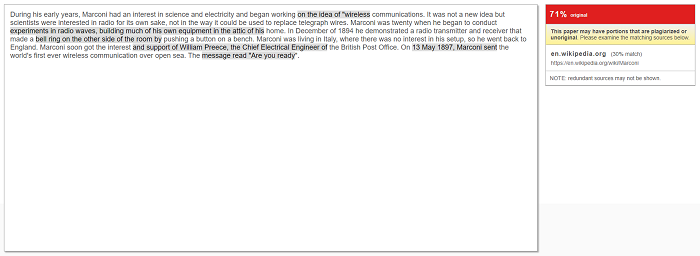
Price: There is a free version limited to five pages per submission for a total of 1,500 words. The paid premium level is $11.21 per month or discounted to $71.55 per year.
In this video by Beth Jones, she shows how to use Paper Rater if you never used it before and if your instructor tells you to submit your paper to a link that the instructor gives you.
Jones says that PaperRater is a good tool but is not perfect for students, so double-check the grammar by proofreading your work as well.
Check out the detailed review of PaperRater →
6. Grades Fixer
Grades Fixer is a free online checker that does not require registration to use it. Simply cut and paste text into the text box on the home page. This tool analyzes any essay type (which is very good for students), published web content, resumes, or other text content.
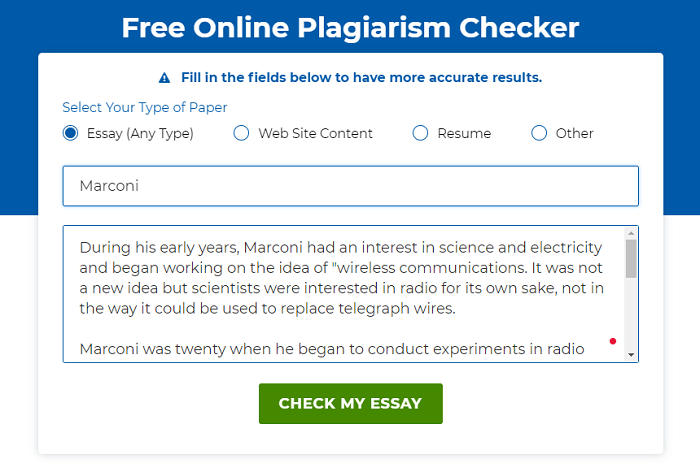
Text Length: 19900 characters per search
Acceptable Formats: Cut and paste any text into the text field for analysis or upload a .doc .docx, .pdf, or .txt file.
Database Size: Searches for duplicate content in over 10 billion sources.
Pros
- Fast. Takes about ten seconds to perform an analysis.
- Matches are highlighted in color-coded ways with red being likely plagiarism.
- Similar text, which can be rewritten to avoid any plagiarism risk, is highlighted in yellow or blue.
- Real-time editing is possible within the plagiarism tool and then it is easier to re-check the edited work.
- Also offers professional essay help for an additional charge.
Cons
- Does not find matches for content from sources that are not on the web, such as some books.
- Cannot be used offline.
- Database does not contain a full assortment of academic journals only the ones that are open source and published on the web.
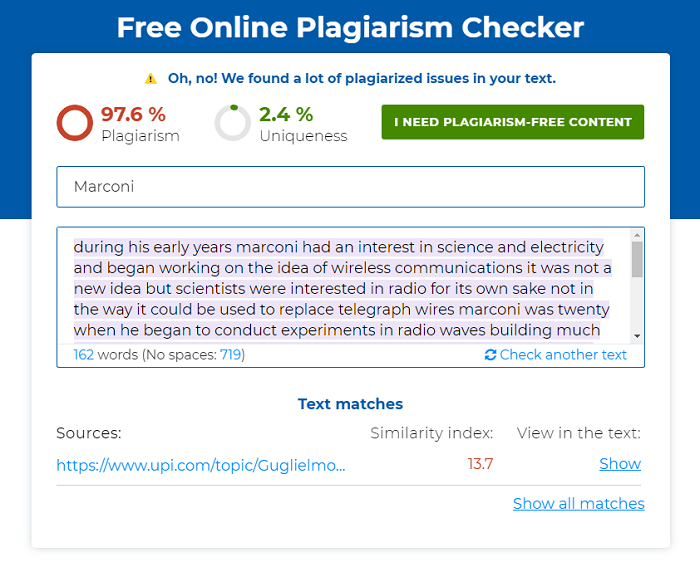
Price: The Grades Fixer checker is 100% free. There is no paid version.
7. Eduzaurus
Eduzaurus is a free online plagiarism checker for students (and not only for them) that does not require any sign up or registration to use.
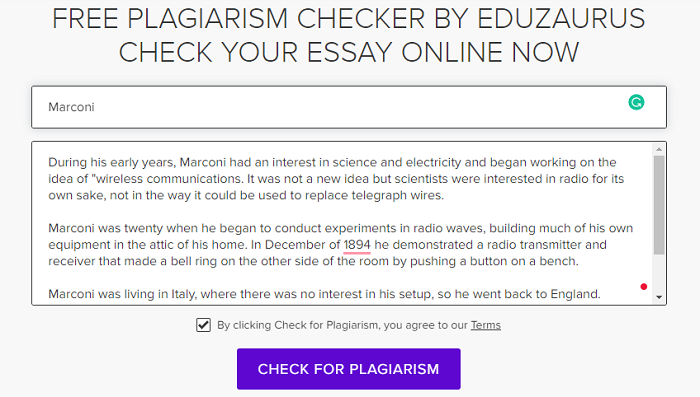
Text Length: 10000 characters per search
Acceptable Formats: Cut and paste text into the text field or upload a document. Accepts .doc, .docx, .odt, .pdf, .rtf. and .txt formats.
Database Size: Uses over 10 billion online published resources for matching analysis.
Pros
- Generates a fast, free, report, with no ads.
- Gives a plagiarism risk score.
- A document can be edited and resubmitted multiple times to improve it.
- No signup, download, or registration is required to use this tool.
- Reports can be downloaded.
Cons
- The database does not contain academic journals that are not published as open source online.
- This system is an advertisement for contract writers paid to write essays for students.
- Website is run by a company based in Bulgaria so they are not native English speakers.
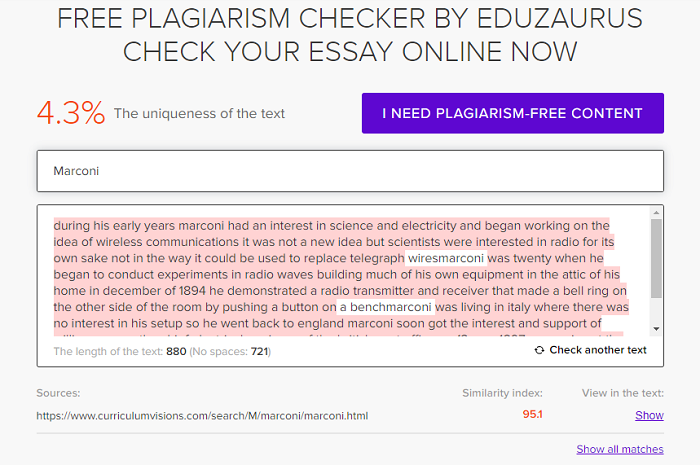
Price: The Eduzaurus is 100% free. There is no paid premium level.
The video, produced by My Research Support, shows some neat tricks on reducing plagiarism in all your papers.
The Indian accent of the narrator is very strong in this video, but the content is excellent. To reduce plagiarism, first, don’t create any as a preventative measure. Don’t copy and paste anything into your paper. Write everything in your own words.
8. PlagiarismChecker.co
PlagiarismChecker.co is a free online tool that uses advanced AI-driven algorithms to analyze students’ papers for plagiarism.

Text Length: 800 words per search.
Acceptable Formats: MS Word, .txt format, and document files in cloud storage, or you can use a URL to scan an entire website for plagiarism.
Database Size: This tool compares billions of published documents on the web, including academic papers, articles, books, journals, magazines, and newspapers.
Pros
- Plagiarism checker works in multiple languages.
- Confidentiality protected. The system does not store, share, or use any uploaded documents.
- Does a deep search of web content.
- Report results are interactive and downloadable.
- Also checks for grammar, spelling, and keyword density.
Cons
- The free online tool is limited to 800 words per search.
- Similarity-checking is limited to web-published content.
- Does not work offline.
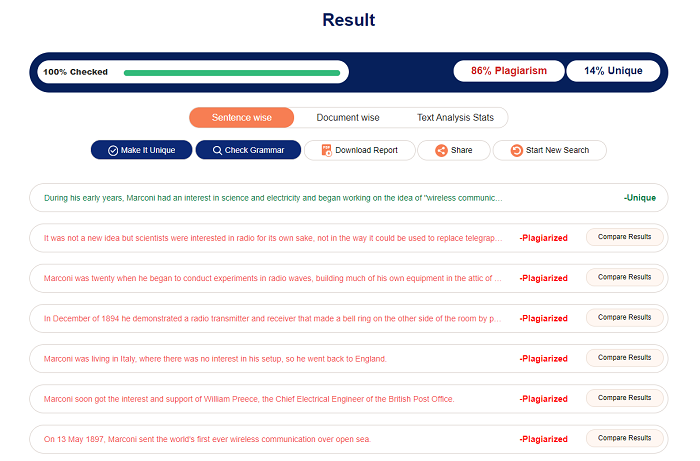
Price: This system has a free version and various levels of paid versions starting with $15/month for the basic level, $20/month for the business level, and $50/month for the enterprise level.
Whether you use a paid plagiarism analysis tool or a free checker, one important skill to learn to help avoid plagiarism is called paraphrasing. Paraphrasing is taking something and rewriting it into your own words.
In this video, produced by Learn English with Emma, the teacher shows how to take essay questions and paraphrase them successfully, so they do not trigger a plagiarism match.
After you practice paraphrasing successfully, you will gain confidence in your writing skills and enjoy the satisfaction of creating unique content on almost any subject matter.
Useful Resources
- What is plagiarism?
- The common types of plagiarism.
- What is self-plagiarism and how can you avoid it?
- How to avoid plagiarism?
Summary
Students need to make plagiarism checking an absolute must for the final editing phase of their papers and that’s why I tested these best plagiarism checkers for students. This fine-tuning may differentiate between academic excellence with its inherent rewards and mediocre, average, or worse efforts.
Another fun way for students to improve their writing is to learn how to write a symbolism essay. A symbolism essay is a critical analysis of the use of imagery in a poem or a novel. Learn how to write a symbolism essay here.


